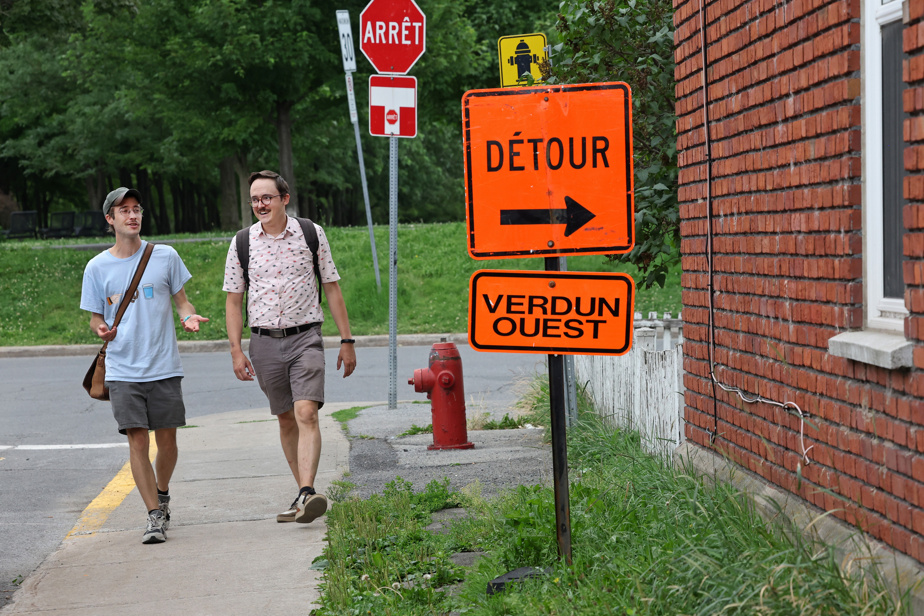The poetry collection Verdunland paints a portrait of an imaginary and wacky neighborhood, but anchored in a well-known Verdun. Through its sometimes wacky, sometimes vulnerable stanzas, readers discover – or rediscover – this corner of Montreal. The Press went to visit him with the two poets.

Verdunland
Your Mother’s Editions, 100 pages
Neighborhood: Verdun; population: 69,000 (2016)
4889 4849 Verdun Street
-

PHOTO ROBERT SKINNER, THE PRESS
The facade of the Tongda Market, rue de Verdun
-

PHOTO ROBERT SKINNER, THE PRESS
Owner Guiming Pan, Timothée-William Lapointe and Baron Marc-André Lévesque
1/2
you could write a hundred poems
about the guy from that convenience store
and there wouldn’t be a single one
in which he would be sad.
Excerpt from the poem “4889, rue de Verdun”
” [Verdun]it’s the kingdom of convenience stores, says Timothée-William Lapointe. There are convenience stores on every street corner!”
It was therefore natural that our visit would begin in a convenience store, specifically the one mentioned in the collection. The blue facade of the Tongda Market, on Rue de Verdun, catches the eye and invites us to enter.
In the back of the store, Guiming Pan, the owner of the place, is stocking his shelves. His face lights up when he greets the two authors. And even more so when he is told the subject of the visit.
Guiming Pan was unaware that he was in the book. His wife and young daughter are behind the cash register and together they discover the poem dedicated to them. The owner points out to the authors that the title of the poem is not the correct address, a mistake they readily admit. “Today is the day we rectify it.” [ça] “, explains Baron Marc-André Lévesque.
While several fantastic and human characters inspired by their surroundings run through the pages of the collection, the “guy from the dep” is the most authentic. “A real person, who is the same in the book as in [Verdun] ? That’s the guy,” says Baron Marc-André Lévesque.
“His joy was already part of Verdunland ” adds Timothée-William Lapointe.
The apartment

PHOTO ROBERT SKINNER, THE PRESS
Baron Marc-André Lévesque and Timothée-William Lapointe in front of their former apartment
Sitting there
tumbled upon ourselves
began to be born in our minds
a new necessity:
that of creating an imaginary world
Excerpt from the poem “The Genesis of Verdunland”
Next stop on the tour: the duo’s former apartment, where it all began. The two friends lived on the first floor of a brick triplex, typical of the neighbourhood. Their apartment in the heart of Verdun was a source of inspiration and a “brainstorming site”, explains Timothée-William Lapointe.
” Verdunland It was built a bit like that. We were on the balcony there, we [lançait] “ideas,” adds Baron Marc-André Lévesque, pointing to the steps of the apartment building.
Sitting for a moment on the steps of their old home, the two poets discuss a possible sequel to Verdunland. For Baron Marc-André Lévesque, who now lives in Hochelaga with his family, this project will be different. “It’s the idea of returning, that is to say that when you go back somewhere, it’s not really the same as it was. Home is more the act of returning, rather than the place itself, because it’s not home anymore.”
The Mobile Park

PHOTO ROBERT SKINNER, THE PRESS
The park may seem ordinary, but it turns into an unusual hero in Verdunland.
Living, sprawling play module
iron mammoth spider
with a little arthritis
The Mobile Park moves on huge legs
and goes to meet the children of the neighborhood
Excerpt from the poem “The Mobile Park”
Parc Monseigneur-J.-A.-Richard, wrongly called Parc Desmarchais in the collection, is one of the many green spaces along the banks of the Saint Lawrence River in Verdun; it is also where the abracadabrant character of the “Parc Mobile” comes to life. The absurd poem of the same name, where a zoomorphic module and revolutionary children rub shoulders, comes straight from the imagination of Timothée-William Lapointe.
With its swings, beige slides and a spider web that climbs towards the sky, the park may look like an ordinary play structure, but it transforms into an unusual hero in the parallel world that is Verdunland. “He’s sleeping right now, but if there are children who are bored, he’ll wake up,” jokes Baron Marc-André Lévesque.
The river

PHOTO ROBERT SKINNER, THE PRESS
In Verdunlandthe river is a recurring element in several poems.
he was telling his solitude with ricochets
on the river and the river was rolling
the reflection of the constellations
Excerpt from the poem “The Star of Verdunland”
A visit to Verdun would not be complete without a walk along the waterfront. In the collection, the river is a recurring element in several poems. In real life, the river is a crucial element in the uniqueness of the neighbourhood praised by many Verdun residents. “We are right on the waterfront, we have access to the river for a good distance,” exclaims Baron Marc-André Lévesque. “I would like to see the Port of Montreal destroyed so that Hochelaga could become [comme] Verdun,” he adds jokingly.
On the water’s edge, inspiration strikes the poets. Their complicity is unmistakable: they throw ideas at each other for a future collection and mention abandoned projects that were not retained for Verdunland“It’s a neighborhood that lends itself to literature,” says Baron Marc-André Lévesque.
“The idea [avec Verdunland]is to encourage everyone to project imagination into their neighborhood and into the city where they live,” emphasizes Timothée-William Lapointe, who will release a new collection of poetry, A life well sleptSeptember 17.
